Table of Contents
|
Elgin Mills
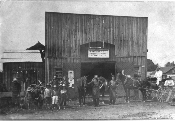 |
| F. J. Woodward's blacksmith shop
at
Elgin Mills, with
the
Glass butcher
wagon on the right. |
Just one sideroad north of
Richmond Hill, where
Elgin Mills Road
today intersects
Yonge Street, was
Elgin Mills. So close
to
Richmond Hill that it
was almost part of the town geographically,
Elgin Mills maintained
a certain pride in its distinctiveness and its own name. Here at mid-century
stood a steam-powered sawmill, a gristmill, and a tannery - all providing work
for
Richmond Hill men.
Here began the
Elgin Mills and
Markham Plank
Road, a toll road running east to present-day
Woodbine Avenue,
then south through
Victoria Square to
Cashel.
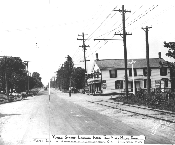 |
| Yonge Street,
looking north from
Elgin Mills
Road, in the 1920s. |
 |
| The
New Elgin
Hotel at
Elgin
Mills |
By 1870,
Elgin Mills was best
known as the location of the
Newton Tanning
Company.James Newton
migrated from Scotland in 1834 and eventually settled in
Elgin Mills, where he
bought a small tanning operation and enlarged it into a major community
enterprise.
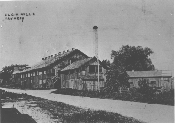 |
| Newton
Tanning Company at
Elgin Mills.
Located on the sideroad west of
Yonge Street
behind the
blacksmith shop on the northwest corner. It was a major employer of
Richmond Hill
labour in the later decades of the nineteenth century. |
In its heyday from the early 1870s through the mid-1890s,
the tannery provided work for as many as one hundred men, many of whom walked
back and forth each day from their
Richmond Hill homes.
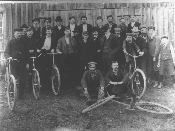 |
| Employees of the
Newton
Tanning Company in 1898. Back row, left to right, are: --,
N. Garness,,
Geo Sims, Sr.,S. Kirkland,Bertram
Newton, --,
- Garbutt, --,
George Hopper,
and
Tom Newton. Front
row:
Dave Mckenzie,
--,
J Brydon,A. Hamilton, --,
F. Dolen, --,
Andrew Newton,C. Skeele,W. Naughton, --,
--, --,
J. Naughton, and
N. Naughton.
Sitting:
L. McLeod,F.
Grainger. |
Newton's
also served as a final stopping-place for old horses and a market for farmers
hauling hemlock bark used in the tanning process. After
Newton's death in
1892 and a severe fire two years later, the tannery continued operations on a
much reduced scale through the late nineties and early years of the twentieth
century. Meanwhile, the opening of a
post
office in 1900 temporarily boosted the identity of
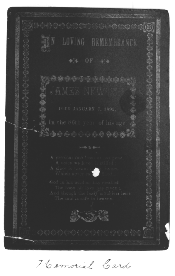 |
| Memorial card of
James Newton,
1892. |
Elgin Mills. But a
century later, the northward march of commercial and residential
Richmond Hill has all
but obliterated
Elgin Mills as a
separate community.
Previous
Next
Copyright © Richmond Hill Public Library Board, 1991
|

